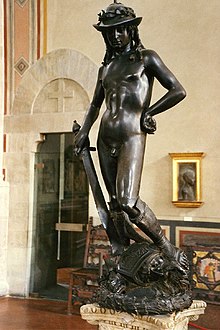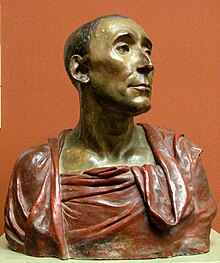Donatello


Donatello (born Donato di Niccolò di Betto Bardi, c. 1386 – 13 December 1466) was an Italian sculptor during the Renaissance. He lived in Florence. He worked in stone, bronze, wood, clay, and wax [1] with several assistants. His reputation as a great artist was stated by Vasari,[2] and has always stood well. He worked in Rome, Sienna and Padua as well as Florence, and worked for the Church, for Cosimo de' Medici, and for various city authorities.
He was born in Florence. He was the son of Niccolo di Betto Bardi. His mother's name is not known. When Donatello was older, he studied with Filippo Brunelleschi the architect. He also helped the sculptor Lorenzo Ghiberti to make statues for the Battistero di San Giovanni.
Donatello's work was inspired by ancient sculpture. He was the first sculptor of his time to celebrate the human body, an idea that had died out after Greek and Roman times. His life-size statue of David is his best-known work.[3] The David is the first known free-standing nude statue made since antiquity. Much of his work was done for display in grand churches. Between 1415 and 1426, he made five statues for the Florence Cathedral, also known as the Duomo.
Donatello was a realist: an artist whose sculpture showed the subjects as real people. Naturalism and the showing of human feelings are his influences.[4]
Related pages[change | change source]
References[change | change source]
- ↑ stucco is a kind of plaster often used for sculpture on buildings
- ↑ Vasari, Giorgio [1556] 1996. Lives of the painters, sculptors and architects, Volumes I and II. Everyman's Library. ISBN 0-679-45101-3
- ↑ Schneider, Laurie 1973. Donatello's bronze David. The Art Bulletin, 55, 213–216.
- ↑ Janson H.W. 1957 The sculpture of Donatello. Princeton University Press.
